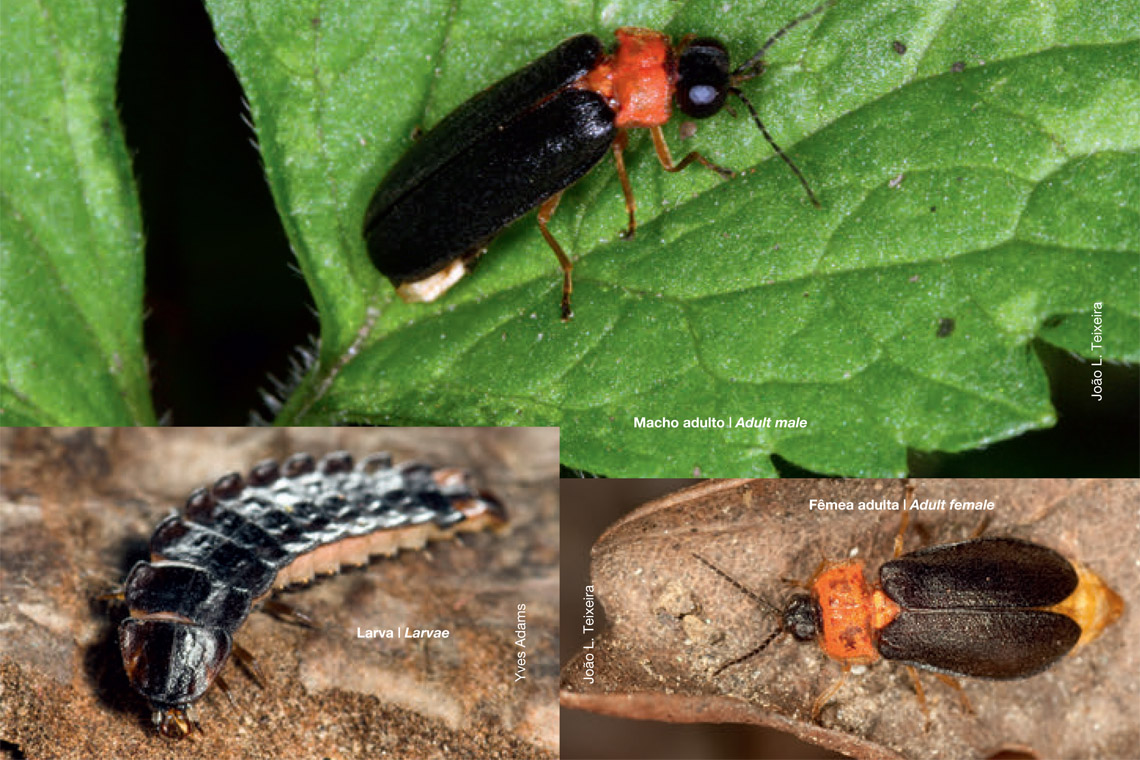Luciola lusitanica (Charpentier, 1825)
This is the most obvious and most abundant species seen during the “Firefly Nights”, i.e. nocturnal walks organised since decades by the Parque Biológico de Gaia.
During flight, the males turn on and off their light at their will. Their emission pattern consist of short single flashes of yellow light with na interflash pause of about 1 second dependent on the temperature (longer flashes and interflashes in colder situations).
Behaviour and where to observe
The larva lives in more humid places than the adults. It doesn’t fly and prefers dark places. When it moves, it emits slow glow pulses lasting several seconds of yellow light just like the adults – the larvae of the other Portuguese species emit lime-green light.
It often shows some orange spots on its further dark-brown back, just dorsally from its light organs on the penultimate body segment.
The underside and lateral sides are coloured pink-beige.
Adult female: most often, found glowing on the ground, a plant, a wall or a rock, and sometimes in the middle of the vegetation (like shrubs or brambles). Emits a long, or even continuous, yet unsteady (“electric”) yellow glow from one segment in its abdomen.
The female has shorter wings and elytra compared to the male and is much plumper and fatter, leaving the terminal segments of the abdomen exposed.
Adult male: Emits yellow flashes of light from two segments of its abdomen. Light is emitted during the night at flight or at rest in the vegetation or also intensively when being handled. At flight, the male typically emits a flash pattern consisting of single flashes approximately every second.
Size
Larva: 4 to 12 mm.
Adult male: 10 to 12 mm.
Adult female: about 10 mm.
Trivia
The rhythm at which the male turns its light on and off is a specific trait of this species. Different populations seem to show dialectical variation in the flash patterns (1) (Papi 1969).
Occurs in Portugal, in the north of Italy, France, Corsica and Sardinia.
There are some ongoing studies (John Day, personal communication) based on genetic analysis that distinguish the Portuguese populations from the French and Italian, suggesting that the portuguese populations may even belong to a different species.
Larvae from the Nice region in France even emit a more greenish light than those seen in Portugal (R. De Cock, pers. obs.).
(1) Papi, F. (1969) Light emission, sex attraction and male flash dialogs in a firefly, Luciola lusitanica (Charp.) Monitore Zool. Ital. 3: 135-184.
Text and photos - «Fireflies and Glow-worms of Portugal», 2015, ISBN n.º 978-989-98330-9-8.




